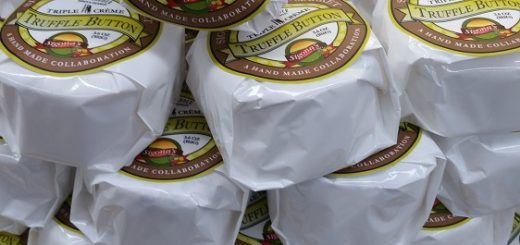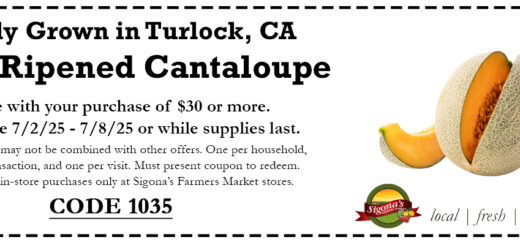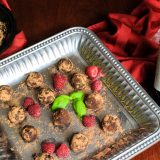Summer’s Delight: Unique & Heirloom Melons at Sigona’s
Summer’s Delight: Unique & Heirloom Melons
By Robbie Sigona
As we move into the height of summer, more melons make their way to our stores. Not just more watermelon, cantaloupe and honeydew, but also both the more rare and unique varieties have started to hit their perfect peak.
Peruse our display of locally grown melons at either store and you’ll soon find yourself enticed by a sweet, aromatic fragrance that gets your mouth watering. We even have some “ugly” melons, those varieties that weren’t bred for their beauty, but for their sweet fruit that melts like butter in your mouth.
I know I’ve said this before, but I’ll say it again: I’m continually wowed by the intense, irreplaceable flavors of a locally grown melon on a hot summer day. Melons are the perfect antidote for high temperatures. Melons help keep body temperatures lower than other foods that take longer to digest.
As they’re made up almost entirely of water, they help keep the body cooler from the start; they’re filling and refreshing without being heavy on calories either. Also, melons are full of electrolytes, minerals and vitamins which help sustain one’s body in hot weather. While melons are refreshing and delicious on their own, be sure to check out our melon recipes for different melons on our blog.
MEET THE GROWERS
We’re so thankful for our local farmers, such as Jim Durst in Yolo County who also grows most of our baby tomatoes, Don Smith, a family farmer with Turlock Fruit Company in Turlock, Calif., and Phil Foster of Pinnacle Organic in Hollister, Calif., who have continued to grow rare pieces of the past alongside some of the more hearty and common varieties.
Heirloom melons are varieties that have been grown without being cross-bred from generation to generation for at least 50 years. We have a handful of true heirlooms in the stores, such as the Haogen. The revival of heirloom products, including certain stone fruits, tomatoes and melons, has been a gift to us that we can now enjoy these very perishable gems.
The Turlock Fruit Company provides us with cantaloupe, honeydew, orange flesh honeydew (my favorite, an outstanding melon), Casaba, Crenshaw, Sharlyn and more. Don, a second-generation farmer, now operates a farm that is four generations strong. Both his son Steve and his grandson Alec are involved in the family business of growing some of the best mixed melons and rare varieties within our local radius.
Phil Foster and his wife Katherine farm about 250 acres over two ranches near Hollister and San Juan Bautista. We’ve worked for them for more than 15 years to bring in their outstanding C.C.O.F. and I.F.O.A.M. certified organic produce. In addition to the organic, heirloom melons, the Fosters provide us with organic heirloom and beefsteak tomatoes as well as organic greens. Phil has incorporated several sustainable practices into his farming techniques to help protect both the crops and environment. For example, they work to build the soil using compost made right there on the farm. They also practice integrated pest management to help minimize the need for any sprays (even though all sprays are organic) whenever possible as biological control is always their primary goal.
OUR FAVORITES? WELL THAT’D BE THE…
It seems that each Sigona’s crew member has their own favorite melon. I love the orange flesh honeydew, but I also like the Tuscan because of its old-fashioned cantaloupe flavor. They may be ugly on the outside, but just as you shouldn’t judge a book by its cover, don’t judge a melon by its rind. What lies beneath is fragrant, juicy and densely flavored.
Uncle Paul likes the Crenshaws, but still holds out for the original, true Crenshaw. We carry excellent Crenshaws, but the true heirloom version isn’t grown for retail anymore because it requires a lot of babying as it grows and doesn’t hold up well for retail.
Uncle Carmelo…now, he’s the true melon fanatic, eating at least two a week and rotating through the varieties. His current favorites are the sweet Sharlyn and the juicy Haogen. The Haogen melon, sometimes called an Ogen, is what he waits for all year to come into season. The ugly, delicate Haogen melons are like none other: super juicy and fragrant with a beautifully green-colored and richly spicy-sweet, smooth flesh.
The Haogen is so delicate it usually bruises on its way to the market, so, firstly, they’re hard to find, and secondly, they aren’t popular among customers. Don’t let that be a turn off, though. We just received a shipment of organic, almost ripe Haogens — they’re so fragrant you can smell them across the room! Hurry in to get one, they won’t last long.
Coming later in the season is another staff favorite: the Kharbouza melon. It’s an elongated yellow-green melon with sweet, crisp (or “crunchy,” as he calls it) flesh and a mild flavor that’s sometimes described as an aged chardonnay. We may get some Kharbouza melons in later this season, so look for them at our store.
We’re able to keep bringing in rare melon varieties from small, local farmers because of you, our customers, who seek out and purchase locally grown produce. Thank you for sustaining the demand for these rare varieties!
Following is information about some of the heirloom melons we carry – there are more varieties in our stores!
The Sharlyn melon is an heirloom variety with a soft, white flesh that is delicate and sweet. The melon itself is more of an oblong shape with a thin orange-red rind characterized with thin, spread out netting. This melon tends to have a loose cavity, meaning that when its cut it’ll have loose seeds, whereas seeds of a cantaloupe or honeydew remain in place.
Selection: The Sharlyn should have a tiny bit of give on the end opposite the stem. If the melon overall has give or is soft, it’s likely overripe.
–
—
 The Casaba melon is an heirloom variety that is hard to miss because of its bright yellow, wrinkly skin and round, walnut-like shape. Its light green, refreshing flesh is very juicy and mildly sweet and floral.
The Casaba melon is an heirloom variety that is hard to miss because of its bright yellow, wrinkly skin and round, walnut-like shape. Its light green, refreshing flesh is very juicy and mildly sweet and floral.
Selection: The Casaba stores forever. You can keep it outside and it will hold well. A sign of readiness is a slightly soft give on the bottom.
–
–
 The Crenshaw melon has a beautiful amber or salmon-colored flesh that’s soft, smooth and sweet. The outside is smooth and yellow, and turns a little golden when ripe (a sign of the original heirloom showing through). Their flavor and pleasant aroma are out-of-this-world. This Crenshaw grown these days is different than the traditional heirloom variety, which is extremely hard to find. They require a lot of babying during the growing process.
The Crenshaw melon has a beautiful amber or salmon-colored flesh that’s soft, smooth and sweet. The outside is smooth and yellow, and turns a little golden when ripe (a sign of the original heirloom showing through). Their flavor and pleasant aroma are out-of-this-world. This Crenshaw grown these days is different than the traditional heirloom variety, which is extremely hard to find. They require a lot of babying during the growing process.
Selection: Ripe Crenshaws will have a slight give on the end and will be slightly fragrant. It will also have areas that are more golden than yellow.
–
–
–
The Haogen melon, a Hungarian heirloom, is a favorite in the Sigona family. It’s so sweetly fragrant you can smell it across the room! The Haogen, sometimes called an Ogen, is a somewhat ugly melon in appearance, with its ribbed, dark green and orange-brown rind. However, its green flesh is spicy-sweet, smooth and juicy.
Selection: -Haogen melons should be soft – they’re a juicy melon. They should give off a fragrant, perfume-y scent
–
–
 The Ambrosia melon has an orange-tan colored cast with a hint of green, similar to a cantaloupe. It’s slightly netted, but smooth. It has a very sweet, tender and pale peachy-orange colored flesh and a pleasant floral fragrance and flavor, as its name hints.
The Ambrosia melon has an orange-tan colored cast with a hint of green, similar to a cantaloupe. It’s slightly netted, but smooth. It has a very sweet, tender and pale peachy-orange colored flesh and a pleasant floral fragrance and flavor, as its name hints.
Selection: The Ambrosia will have a little give on the end, but should remain overall firm. From the outside, they’re easy to confuse with cantaloupe, but the Ambrosia is generally bigger.
–
–
The Crane melon is an heirloom variety developed in the early 1900s in Santa Rosa, Calif., by Oliver Crane. It’s a hybrid product of several melons, including a Japanese melon, a white melon, a Persian melon and an Ambrosia melon. Crane melons are round with very aromatic light orange flesh that’s sweet and juicy. The Crane family is still cultivating the Crane melon and for more than 80 years and six generations, they still operate out of the Crane Melon Barn in Santa Rosa. Cranes are generally available in late September.
Selection: This variety is very perishable. It should have a little give, but not too much. Get it in the fridge when you get it home.
—
–
 The orange flesh honeydew has a smooth outside skin like the green, but it has a definite orange hue. The orange-fleshed honeydew has rich, heavy sweet aromas, dense cantaloupe-colored flesh with honey sweetness and hints of herbs like herb de Provence, lavender, and rosemary. It is a staff favorite at Sigona’s.
The orange flesh honeydew has a smooth outside skin like the green, but it has a definite orange hue. The orange-fleshed honeydew has rich, heavy sweet aromas, dense cantaloupe-colored flesh with honey sweetness and hints of herbs like herb de Provence, lavender, and rosemary. It is a staff favorite at Sigona’s.
Selection: This melon has a smooth cast, with a good, uniform yellowish color. When ripe, as with other smooth melons, the orange flesh should have a waxy, feel on the outside. If they have a give, they’ll likely be too ripe.
–
–
Charentais melons (pronounced sha-rahn-tay) have smooth, grey-green netted rinds and a very fragrant orange flesh. A ripened Charentais gives off a refreshing, delicious aroma. They are said to have originated in Cavaillon, France, and are sometimes sold under this name. If you wish cantaloupe had a deeper flavor, you’ll love the Charentais.
Selection: This netted melon should have slightly more give than a ripe cantaloupe all round, but almost no give on the stem end.
–
—
 The Tuscan melon, also known as a Tuscan-style cantaloupe, has a firm, dense flesh which stands up on its own and in salads. It pairs well with stronger flavors and retains its own juices.
The Tuscan melon, also known as a Tuscan-style cantaloupe, has a firm, dense flesh which stands up on its own and in salads. It pairs well with stronger flavors and retains its own juices.
Selection: The netted Tuscan also has ridges. Look for pronounced ridges, healthy netting and distinct color variation. In this case, look for a healthy tan and deep green color and for decent give on the end opposite the stem.
–
–
Galia melons are highly aromatic and have pale green flesh that’s packed with juice. Galias, a netted melon, are incredibly sweet with a texture similar to a watermelon.
Selection: Look for a Galia that overall has a bit of give. They have a telltale dark golden colored ring under the netting when they’re ripe.
–

















